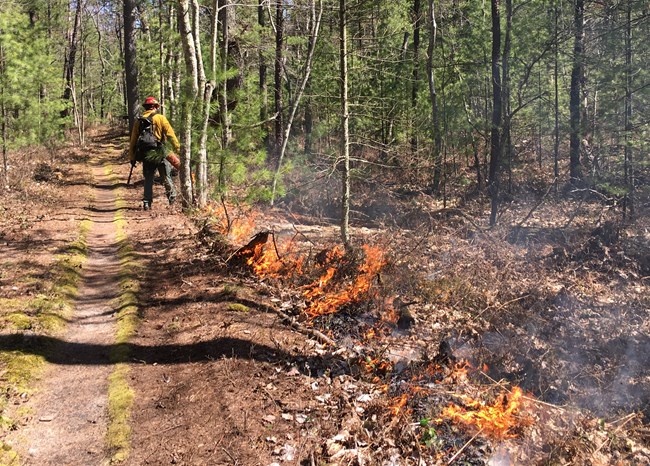Last updated: May 17, 2019
Article
First Ever Prescribed Fire at Sleeping Bear Dunes

NPS/Grissmer
Prescribed fire is used to maintain healthy ecosystems, replenish fire-dependent ecosystems, reduce available fuels in the event of wildfire, and assist with the management of invasive species. The Platte Plains area contains unique, fire-dependent plant communities known as dry northern forest and wooded swales (low areas between post-glacial ridges). Logging and suppression of naturally occurring wildfires led to the decline of these forest types in the Great Lakes region. Red and jack pine - common trees in these communities - usually rely on fire to regenerate, and many of the plants found within wooded swales need openings in the canopy for access to sunlight. Without fire as a disturbance, hardwood species and shrubs eventually out compete the pines, altering community composition and canopy structure. Conserving these high-quality remnants through prescribed fires will allow National Lakeshore visitors to continue to experience an ecosystem that represents a bygone, wild component of Michigan’s natural history.
In addition to being the first ever broadcast burn at Sleeping Bear Dunes, crews had to manage for unique conditions such as piping plover habitat, two campgrounds in or near the burn area, a Michigan scenic byway running along the burn units, and multiple in-holdings of private property. Working diligently since the burn plan was approved, staff from Sleeping Bear Dunes and the NPS Great Lakes Fire Management Zone prepared control lines, contingency plans, and public education and outreach to ensure a successful first-ever prescribed fire.
The Great Lakes Restoration Initiative (GLRI) provided funding for this prescribed fire as part of its purpose in protecting and restoring the largest system of fresh surface water in the world – the Great Lakes. The Platte Plains prescribed fire supports GLRI’s goals of protecting native plant and animal habitat as well as the control of invasive plant species around the Great Lakes.
Future plans for using prescribed fires to restore similar plant communities in the National Lakeshore include two additional units in the Platte Plains area and 3 units in the Good Harbor Bay area. Fire effects monitoring plots that were established prior to this prescribed fire will be resampled and analyzed to provide scientific information on the effects of the fire on the plant community. Findings from this and ongoing research into the fire history of the area will be used by management staff in planning future prescribed fires and other restoration actions of these unique ecosystems.

NPS/M. Bell
